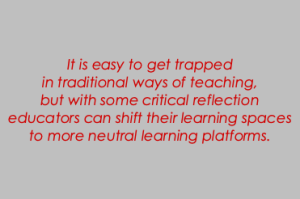By Christine Smart-Wiseman
I have spent over a decade developing my research in community-setting adult ESL classes. I have found the path to empowerment for newcomers somewhat difficult. Students face many obstacles, including discrimination, racism, and the increasing challenges of settling into a country where English is not their first language. I have also realized that my own positionality, as well as the positionalities presented in teaching materials, can compromise students’ abilities to relate and succeed. This means that my own ideas, and the ideas presented in ready-made materials, often reflect the status quo—not the typical adult ESL learner. So, what can we do about this in the classroom? There are two key ways educators can critically reflect on their teaching practices.
First, as a doctoral student, my primary research focused on my positionality, which simply means how I see the world. Upon reflection, I noticed that I unknowingly subscribed to what Freire (1970) calls the banking model of education, which mirrors traditional teaching methods. In this model, the teacher stands and teaches at the front of the class while students are passive recipients of the “almighty” knowledge the teacher upholds. Thankfully, I have changed! Have you? Will you? Do you take the time to reflect on your teaching practices and consider the consequences of what and how you teach? Do you critically reflect on the teaching materials you offer as learning tools to students?
Second, integration should reflect all cultures in the classroom. It is important for students’ voices to be heard and respected in the class. At times, educators subconsciously confuse assimilation with integration. From my perspective, integration is a two-way street where we learn from each other, or what Freire (1970) calls “conscientização” (a Portuguese term), which develops out of engaging in dialogue. This is also known in English as ‘critical social consciousness’ (Shor, 2009). As a result, integration involves the ability for students and educators to adapt and change. Do you invite others to share their knowledge in the classroom? Do you view integration as a reciprocal act? Do the dialogues in your classrooms invite knowledge sharing, or is there a one-way mentality brewing?
It is easy to get trapped in traditional ways of teaching, but with some critical reflection, educators can shift their learning spaces to more neutral learning platforms. This will enhance pathways to empowerment for newcomers. As educators, we need to start making these changes by looking at ourselves first and questioning what it is we are teaching and why.
What steps do you take to unravel disempowering practices in the classroom?
References
Freire, P. (1970). Pedagogy of the oppressed. The Continuum International Publishing Group Inc.
Shor, I. (2009). What is critical literacy? In A. Darder, M. P. Baltodano, & R. D. Torres (Eds.), The critical pedagogy reader. Routledge
Dr. Smart-Wiseman is passionate about uncovering ways to foster social justice. They believe that teaching and learning spaces should enable active and equal membership in society. They have been teaching ELL for over 20 years. In addition, they are a self-proclaimed “life learner” and recently defended their PhD thesis. Dr. Smart-Wiseman is excited to connect with like-minded professionals, so feel free to contact them!

